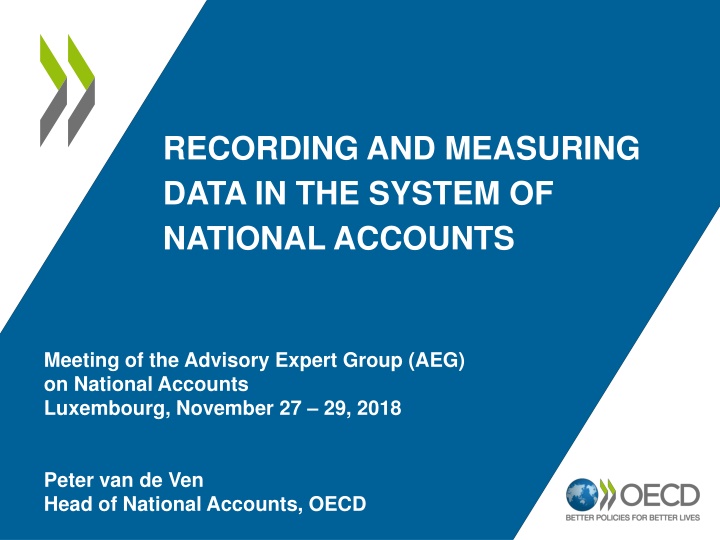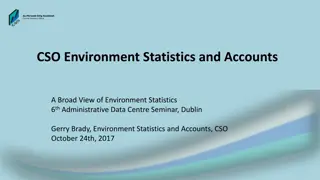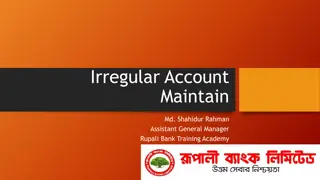Meeting of the Advisory Expert Group on National Accounts
This content discusses the recording and measuring of data in the system of national accounts, focusing on discussions leading up to the 2008 SNA. It covers the potential for data-driven business models, definitions from the 2008 SNA, and the treatment of data as non-produced assets in market transactions. The underlying value of data, its contribution to production, and why data itself is not recognized are also explored.
Download Presentation

Please find below an Image/Link to download the presentation.
The content on the website is provided AS IS for your information and personal use only. It may not be sold, licensed, or shared on other websites without obtaining consent from the author.If you encounter any issues during the download, it is possible that the publisher has removed the file from their server.
You are allowed to download the files provided on this website for personal or commercial use, subject to the condition that they are used lawfully. All files are the property of their respective owners.
The content on the website is provided AS IS for your information and personal use only. It may not be sold, licensed, or shared on other websites without obtaining consent from the author.
E N D
Presentation Transcript
RECORDING AND MEASURING DATA IN THE SYSTEM OF NATIONAL ACCOUNTS Meeting of the Advisory Expert Group (AEG) on National Accounts Luxembourg, November 27 29, 2018 Peter van de Ven Head of National Accounts, OECD
Overview Discussions leading up to the 2008 SNA Data-driven business models Potential for recording and measurement Summary and way forward
Definitions from the 2008 SNA The cost of preparing data in the appropriate format is included in the cost of the database but not the cost of acquiring or producing the data The creation of a database will generally have to be estimated by a sum-of-costs approach Other costs will include staff time estimated on the basis of the amount of time spent in developing the database, an estimate of the capital services of the assets used in developing the database and costs of items used as intermediate consumption The cost of the data base management system (DBMS) used should not be included in the costs but be treated as a computer software asset unless it is used under an operating lease 4
Data recorded as non-produced assets, in case of market transaction Decision not to treat the data, in and of itself, as produced does not mean that data has no value Future benefits can very clearly be derived from data, either through the sale of a database (including the value of the data), or in creating additional value added in support of the production of other goods and services, such as advertising In the former case (market transaction), the 2008 SNA captures the value of data as goodwill (which de facto means that data are treated as a non-produced asset) In the latter case, although data remains in and of itself invisible, its contribution to production is accurately reflected 5
Why data itself is not recognised The underlying value of data reflects its information or knowledge content Valuing all data as a non-produced assets would de facto require that all knowledge, including human capital, be treated as a non-produced assets Although it may be meaningful to recognise knowledge based assets (including as produced assets), it would require methods that are internationally comparable, feasible and meaningful => not (yet) possible 6
Electronic data and knowledge Part of the thought process: electronic data different to other forms of data, which could merit its inclusion as a produced and distinct type of data? Underlying value of the data does not reflect its electronic characteristics, but, rather, the inherent and intrinsic value of the knowledge or information => not possible to make a credible distinction between various types of data (or more broadly, knowledge) Knowledge/information embodied in databases contains asset characteristics, but knowledge displays these characteristics whether it s embodied in a database or not 7
The increasing role of data Digitisation has led to a proliferation in the role of data in economic decision making and society at large Jon Brock et al (2013): From the dawn of time until 2003 some 5 exabytes, according to Intel is now created every two days , while Data processing and storage costs have decreased by a factor of more than 1,000 over the past decade No signs of slowing; on the contrary, data are used at an ever increasing speed, with new technologies for storage and analysis of data becoming available 9
Data-driven business models Providing services for free or at very low prices to gather data of users, which are subsequently used to detect behavioural patterns to provide other producers with targeted advertising services, or to offer other services Google Ads, Facebook Using information from payment systems, to provide other services like specialised accounting services, support in taxation and pension arrangements, etc. Using data generated as part of the primary production process, to improve the efficiency of the internal operations and/or to detect behavioural pattern to support own sales Amazon using dynamically generated recommendations VISA applying integrated analytics to detect fraudulent transactions Car manufacturers using data automatically created and stored by the car s electronics 10
Data-driven business models Creation of new types of services by using and analysing big data Swarmly, a smartphone application where users can share their current location and provide details of their sentiments, after which data are aggregated to provide a real-time map of popular venues GoSquared, Mixpanel and Spinnakr, which use tracking codes embedded in customers websites, and provide analytics through a Web-based dashboard Provision of data-related services, by collecting data from a vast number of different, mostly free, available data sources, normalizing formats and providing access, with revenues from subscription or usage fees (including conducting data analytics) Gnip (premium reseller of Twitter data) Consultancy services, such as fraud detection services, analytics to improve marketing activities and customer service, or to simply increase sales 11
Barter-type of transactions Data only materialises as a non-produced asset, when a market transaction occurs is being tested by recent developments Our starting point: arguments for not recognising knowledge creation remain valid But what to do with barter-type transactions, in which free services are being traded for data? Note: not all data captured from households is matched by a provision of services (e.g. data collected by supermarkets) 13
Valuation methods Market-equivalent prices (digital identity data versus digital footprint data) Assuming a certain relationship between (advertising) revenues and the value of the free services (and the related value of data) User-based valuations: actual market prices, or shadow prices based on willingness to pay 14
Non-produced versus produced 2008 SNA: Data treated as non-produced assets Extension to barter transactions in data will increase GDP, even if considered as non- produced assets Treating data as produced assets may lead to a triple impact on GDP: Own-account production of the original Subsequent sale and build-up of database Use of the asset Not addressing the bigger question of recording knowledge creation as a production process more generally 15
Summary and way forward Current (2008) SNA not well equipped to reveal the increasing role of data Potential (partial) solutions: Have a separate asset category for data Extend the recording of data to barter-type of transactions Extend the sum of costs method for valuing databases to data analytics (and storage costs) Further extension to non-barter-type of data flows? => Note: requires the recording of current transfers Not go the way of considering data as produced assets 17
Questions and issues for the AEG The AEG is requested to provide its opinion on: the way forward regarding the recording and measurement of the role of data, both from a conceptual and a measurement point of view the possible extension of the asset boundary, by including the work of data analytics and storage costs in the sum of costs approach for measuring databases, as currently defined in the 2008 SNA the further extension of the asset boundary, by including data acquired through bartering mechanisms, either as non-produced assets or produced assets extending the production boundary beyond the above 18























